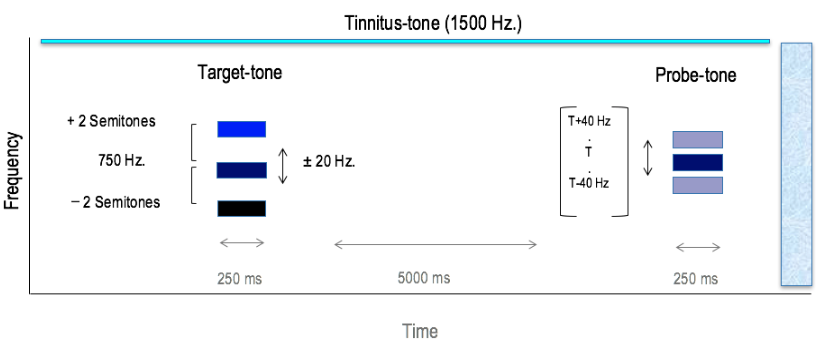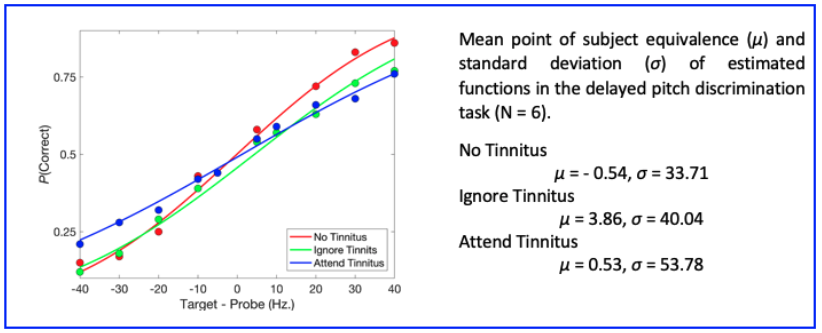



Mike Pilling and I were both at the MRC's Institute of Hearing Research, and this project was based on our ongoing interest in auditory cognition. David Souto is a colleague at Leicester, who helped with the pre-processing and analysis of pupillometry data. We were also lucky to have Dave Baguley from Nottingham University's Hearing Science Group working with us. Sadly, Dave is no longer with us, but I have listed his UoN affiliation, and you can read about him at the link below.
| Web | ||
|---|---|---|
| Mike Pilling | mpilling@brookes.ac.uk | Oxford Brookes University |
| David Souto | ds572@le.ac.uk | School of Psychology & Vision Sciences |
| Dave Baguley | University of Nottingham |
Tinnitus is the perception of sound in the absence of an external auditory stimulus. In the UK, approximately 10% of the population report chronic tinnitus, with half of these describing their condition as moderately or severely distressing. As tinnitus is an internal percept, its magnitude and severity are difficult to assess, and current clinical evaluation is based on subjective measures. Correlations between audiometric estimates of tinnitus and levels of distress, however, are generally low, and there is currently no objective measure of the impact of tinnitus on hearing. Although the cause of tinnitus is likely to reflect physiology processes in the auditory pathway, its impact on the listener appears to be mediated by cognitive and emotional components. Recent models suggest problem tinnitus is associated with plastic changes in connectivity between auditory cortex and the limbic system and a maladaptive bias to attend the tinnitus percept. Such a bias is likely to impact negatively on hearing; as the perceptual and cognitive resources used to process external sounds are diverted towards the internal percept.
Mike and I tested whether tinnitus could have a measurable impact on auditory recall by manipulating the locus of attention towards or away from simulated tinnitus during a delayed pitch discrimination task. Listeners with normal hearing compared the pitch of two tones separated by a 5 second retention interval. The frequency-difference between tones was varied using a method of constant stimuli, and the variance of the resulting psychometric function was used to index the precision of recall.

Figure 1. Illustration of stimuli on a single trial of the delayed pitch discrimination task. Target tones were centred at 3 frequencies: 750 Hz. ± 2 semitones, with a randomly assigned jitter of ± 20 Hz on each trial. Probe tones were presented at a range of values ± 40 Hz and participants judged whether the probe was higher or lower in pitch than the target. On a subset of trials, a 1500 Hz tone was used to simulate tinnitus. The amplitude of simulated tinnitus was constant, or sinewave modulated, and participants were asked to ignore the tone or report whether its amplitude was constant or changed.

Figure 2. Estimated psychometric functions for mean pitch discrimination judgements in the No-Tinnitus, Ignore-Tinnitus and Attend-Tinnitus conditions. Shallower slopes indicate a decrease in the precision of recall for target tones presented in the presence of simulated tinnitus. The decrease was larger when listeners were required to attend (report) compared to ignore the tinnitus tone.
The results reveal a decrease in precision when tones were presented in the presence of simulated tinnitus compared to silence. When participants were required to report the amplitude of simulated tinnitus, the decrease in precision was significantly larger than that in the silent baseline condition. When participants were instructed to ignore simulated tinnitus, the reduction in precision was smaller and did not reach statistical significance. These findings with simulated tinnitus, suggest measures of auditory short-term memory may be sensitive to changes in the competitive weights assigned to tinnitus and external sounds during the encoding, maintenance, and evaluation of external sounds.
In a second study, we were interested in whether the results above would generalise to individuals with clinical tinnitus. Instead of measuring changes in the precision of auditory STM, this experiment was designed to measure the potential impact of tinnitus on the level of effort required during the retention of sounds. To do this, we employed a delayed pitch discrimination task similar to the one described above to measure task-evoked pupillary responses (TEPRs). Rather than varying the frequency difference between the target and probe tones using the method of constant stimuli, we used an adaptive psychophysical procedure to estimate individual frequency detection thresholds to ensure the accuracy of delayed pitch discrimination was equivalent for listeners with and without tinnitus.
Twelve participants with chronic tinnitus (TG) were recruited to the study from the local community. All had experienced tinnitus in one or both ears for at least six months. Twelve participants with no history of tinnitus or neurological disorder were recruited as a control group (CG) for the study. None of the participants wore hearing aids and differences in the age of each group were not statistically significant.

Figure 3. Mean baseline corrected pupil dilation for Control (CG) and Tinnitus (TG) groups by time and block in arbitrary units. Vertical dotted lines denote the offset and onset of the probe and target tones, respectively.
The data above illustrate an increase in the magnitude of mean TEPRs in TG compared to CG during the retention of the target tone on the delayed pitch discrimination task. A mixed linear effects (MLE) analysis on maximum baseline corrected TEPRs revealed a significantly larger phasic increase in pupil dilation for TG compared to CG listeners. Estimated coefficients for the differences between blocks did not reach statistical significance, and nor did those for the Group by Block interactions. These results indicate TEPRs were significantly larger among TG than CG participants across all blocks of testing. To investigate the relationship between TEPRs and subjective measures of tinnitus, we calculated a simple regression with Tinnitus Handicap Inventory (THI) scores the predictor and the mean of participants’ maximum TEPR across blocks the outcome. A significant regression equation was obtained (F1,10 = 16.15, p < 0.05) with an adjusted R2 of 0.58. This indicates that for every unit increase in THI, maximum pupil dilation in TG listeners increased by 0.8 arbitrary units compared to baseline.
The results of the study indicate tinnitus elicits measurable effects on phasic changes in pupil size during tests of auditory short-term memory. This increase in TEPR amplitude among TG listeners is consistent with the prediction that competition between tinnitus and external sounds increases listening effort during tests of auditory short-term memory. The level of this competition is likely to reflect attentional mechanisms, which determine the distribution of cognitive resources across internal and external precepts during hearing. This result supports previous evidence for the role of central, cognitive mechanisms in the presentation and maintenance of troublesome tinnitus and suggests task-related changes in phasic pupil size can be used to measure the impact of tinnitus on listening effort on a test of auditory short-term memory. Future work to validate this result, will require replication with a larger sample that is representative of the clinical population with troublesome tinnitus. Our initial results, however, suggest pupillometric indices of listening effort have the potential to provide clinicians an objective measure of tinnitus severity and a means to assess the efficacy of treatment.
Publications relating to this project are linked below. David Baguely also published widely in this area of research.
Barrett, D. J. K., Souto, D., Pilling, M., & Baguley, D. (2022). An exploratory investigation of pupillometry as a measure of tinnitus intrusiveness on a test of auditory short-term memory. Ear and Hearing, 43, 1540-1548. doi:10.1097/AUD.0000000000001214
Barrett, D. J. K., & Pilling, M. (2017). Evaluating the precision of auditory sensory memory as an index of intrusion in tinnitus. Ear and Hearing, 38(2), doi:10.1097/AUD.0000000000000367

This project was supported by an undergraduate bursary from Action on Hearing Loss, which is now known as the Royal National Institute for Deaf People.